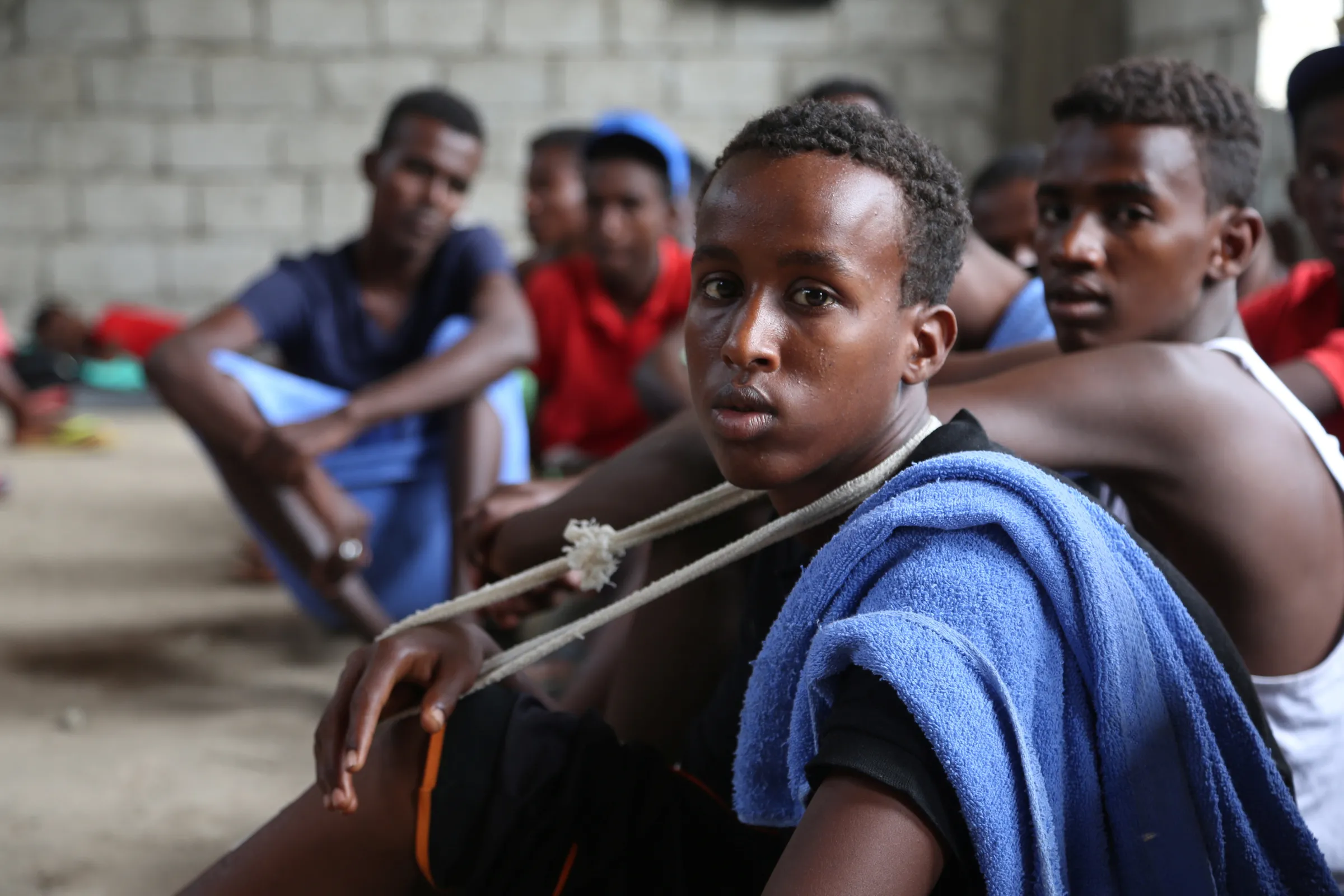Forgotten migrants: Africans risking lives in war-hit Yemen

Somali refugees who survived an attack on a boat off Yemen's coast in the Red Sea sit at a detention center in the Houthi-held port of Hodeidah, Yemen, March 22, 2017. REUTERS/Abduljabbar Zeyad
What’s the context?
Every year, thousands of Ethiopians and Somalis brave smugglers and deserts to cross Yemen, hoping to find work in Saudi Arabia.
NAIROBI - At least 54 migrants died after a boat carrying about 150 people sank off Yemen's coast in bad weather this week in the latest disaster to cast a spotlight on a perilous and often overlooked migration route.
Reuters reported that 10 people were rescued - nine Ethiopians and one Yemeni - but dozens were still missing after the boat capsized on Sunday off Yemen's southern Abyan province in the Arabian Sea.
Each year, hundreds of thousands of Ethiopians and Somalis cross the Gulf of Aden in overcrowded boats and trek through war-torn Yemen, braving smugglers and deserts to get to Saudi Arabia where they hope to find work.
Instead, many face exploitation and violence and risk being caught in the crossfire of war.
Here's what you need to know.
Who are the migrants travelling through Yemen?
Most migrants leaving the Horn of Africa are young people from Somalia and Ethopia. Many are from Ethiopia's Oromia and Amhara regions, fleeing high unemployment, political instability, ethnic violence and climate disasters like droughts and floods.
They are hoping to find work in Gulf nations, especially Saudi Arabia and Oman, via the so-called Eastern Route, which runs through Djibouti, across the Gulf of Aden and through Yemen.
It is described by the International Organization for Migration (IOM) as one of the world's busiest and riskiest migration corridors.
Why do people risk this dangerous route?
Economic desperation is the primary driver. Decades of conflict, poverty and climate shocks have left many in the Horn of Africa with few opportunities.
Fighting between Ethiopian government forces and the Tigray People's Liberation Front has killed thousands and displaced more than 2 million people. Somalia faces worsening droughts, with millions losing livelihoods and displaced by water scarcity.
Demand for informal labour is high in the booming economies of the Gulf, and migrants hope to earn enough to send money back home to their families.
Yemen's proximity to the Horn of Africa and its porous borders with Saudi Arabia make it a key transit point, despite its own ongoing civil war and humanitarian crisis.

Rescuers stand at the site of a strike at a detention centre hosting African migrants, in Saada, Yemen April 28, 2025. REUTERS/Naif Rahma
Rescuers stand at the site of a strike at a detention centre hosting African migrants, in Saada, Yemen April 28, 2025. REUTERS/Naif Rahma
What dangers and abuses do migrants face in Yemen?
Migrants risk death, injury and being caught between warring factions, as well as abuse from armed groups, Saudi border guards and smugglers.
Others drown when their boats sink. The IOM's Missing Migrants Project estimates that at least 1,900 people, including women and children, died in Yemen in 2024.
Migrants also face arbitrary detention, torture or disappearances at the hands of armed groups, including Yemen's Houthi rebels and government-aligned forces.
Smugglers extort migrants, sometimes forcing them to work or join armed groups or subject them to sexual abuse, according to human rights groups.
As they trek hundreds of kilometres on foot, migrants can run out of food and water. They have little access to medical care or basic services and may become stranded, unable to continue or return home.
Those held in detention centres run by the Houthi rebels and the Yemeni and Saudi governments face overcrowded, unsanitary and abusive conditions, according to Human Rights Watch.
The centres have also been hit in U.S. airstrikes targetting the Houthis. In April, at least 68 African migrants were killed after a suspected U.S. airstrike in Saada.
How many migrants are affected, and why does the media pay so little attention to this crisis?
The United Nations estimates more than 200,000 African migrants are in Yemen, with at least 43,000 people stranded.
Arrivals surged to a record in 2023, driven by increased economic hardship and conflict in Ethiopia.
Tightened security and patrols by Djibouti and Yemeni coastguards have pushed more migrants to cross from Somalia's Puntland region. Environmental pressures such as droughts also contributed to a rise in Somali migrants.
The war in Yemen means it is difficult for aid agencies and human rights groups to document abuses and gather reliable data.
Migration experts say the international media is largely focused on routes affecting Western countries, such as across the Mediterranean Sea, and neglect the crisis in Yemen.
This story was updated on August 5, 2025 with changes throughout.
(Reporting by Nita Bhalla; Editing by Ayla Jean Yackley.)
Context is powered by the Thomson Reuters Foundation Newsroom.
Our Standards: Thomson Reuters Trust Principles
Tags
- Government aid
- Race and inequality
- War and conflict
- Migration

















